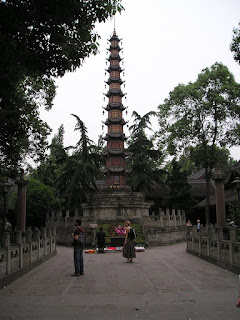
During my trip to Chengdu, China, we took a day trip to the Chinese equivalent of a national park (children, retired, and national moral heroes can enter at a reduced cost!) near the city of Leshan, also in the Sichuan Province. This park is mainly known for the massive Buddha that is carved into the cliff along the river, but the park also has much more to offer in terms of temples, shrines, gardens, and walking/low-scale hiking. The picture above is along the path leading up to the Giant Buddha.
 This picture actually includes the Buddha's knee and hand resting upon it. The total height of the Buddha is approximately 23 stories.
This picture actually includes the Buddha's knee and hand resting upon it. The total height of the Buddha is approximately 23 stories. The Buddha dates from 713 AD and was carved with a drainage system included to prevent erosion. Air pollution has taken its toll, but the overall feat is still incredibly impressive.
The Buddha dates from 713 AD and was carved with a drainage system included to prevent erosion. Air pollution has taken its toll, but the overall feat is still incredibly impressive. The stairs pass down one side of the Buddha and allow visitors to pass in front before departing along another riverside path.
The stairs pass down one side of the Buddha and allow visitors to pass in front before departing along another riverside path. The cliffs are also dotted with many other smaller carvings, many of which have not fared as well against weather and exposure.
The cliffs are also dotted with many other smaller carvings, many of which have not fared as well against weather and exposure. The river view is quite incredible here too, with the city of Leshan on the opposite side sitting between two forks of the river.
The river view is quite incredible here too, with the city of Leshan on the opposite side sitting between two forks of the river.
Further back in the park are a myriad number of other shrines, including a cave complex.
 One of the cave exits pans out to this entryway, again quite impressive!
One of the cave exits pans out to this entryway, again quite impressive!
At the very bottom of the valley surrounded by these shrines is a single fountain with still water, complete with a stone frog at the bottom, ready to take any contributions!









